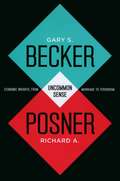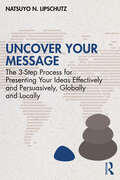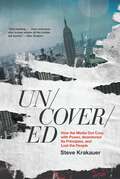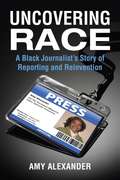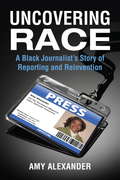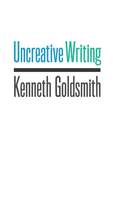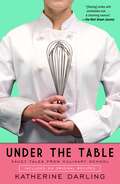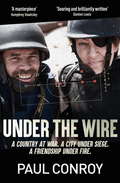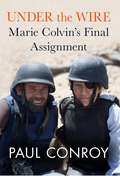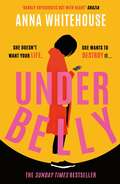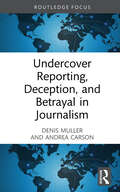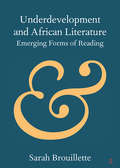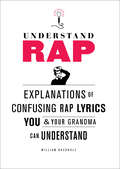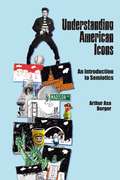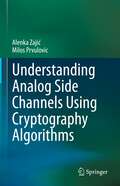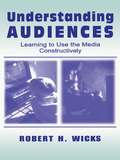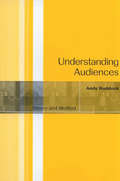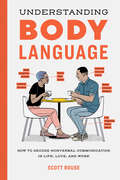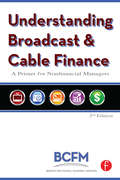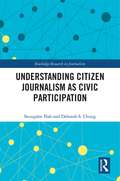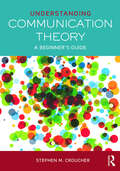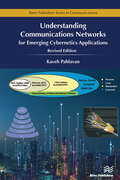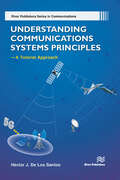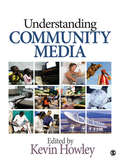- Table View
- List View
Uncommon Grit: A Photographic Journey Through Navy SEAL Training
by D. McBurnettRetired Navy SEAL and professional photographer Darren McBurnett takes readers behind the scenes into the elite SEAL training program, BUD/S, in Coronado, California. Striking, beautiful, and haunting, Uncommon Grit takes a unique, unprecedented look at the toughest training in the military -- and the world -- from the vantage point of someone who lived through it. Retired Navy SEAL Darren McBurnett includes vivid descriptions of both the physical and mental evolutions that occur as a result of the immensely challenging SEAL training process.His stunning photographs, partnered with his compelling insights and sharp sense of humor, allow the reader to laugh, cringe, gasp, and even envision themselves going through this extraordinary experience.
Uncommon Sense: Economic Insights, from Marriage to Terrorism
by Richard A. Posner Gary S. BeckerA commentary on current events and economic issues, gathering the authors' most important and innovative entries.
Uncover Your Message: The 3-Step Process for Presenting Your Ideas Effectively and Persuasively, Globally and Locally
by Natsuyo N. LipschutzWritten by a non-native English-speaking professional speaker with over 20 years of international consulting experience, this book lays out a step-by-step process to improve cross-cultural communication skills and achieve a strong global presence.Every year, organizations lose money, time, and people due to poor or inefficient cross-cultural communication – and this can be as easily between departments or individuals within an organization as across oceans. To tackle this widespread problem, Natsuyo N. Lipschutz developed the 3-step process she calls the “3As” (Acknowledge, Analyze, Adapt), using a unique multilayered approach: cross-culture × logical thinking × storytelling. Using the 3As process, readers will improve their awareness of cultural differences and learn analytical and logical thinking skills to zero in on their own unique message, tell persuasive stories, and ultimately get their messages not only clearly heard but acted upon in a culturally diverse global business environment.Filled with lessons and real-life stories from global companies and executives who benefited from Natsuyo’s guidance, this book will appeal to any business leader who needs to communicate with a diverse range of stakeholders, whether in a different country or a different team, to persuade and succeed.
Uncovered: How the Media Got Cozy with Power, Abandoned Its Principles, and Lost the People
by Steve KrakauerFrom the COVID lab leak theory to Hunter Biden's laptop to Jeffrey Epstein, media critic and former CNN producer Steve Krakauer spotlights the problems of a news industry filled with geographically isolated, introspection-free, egomaniacal journalists. In Uncovered, America&’s sharpest media critic, former CNN insider Steve Krakauer, reveals exactly what went wrong—and why the media went off the rails. The fourth estate is supposed to be a conduit to the people and a check on power. But instead, we have geographically isolated, introspection-free, cozy-with-power, egomaniacal journalists thirsty for elite approval. Krakauer dives deep into some of the most egregious examples of the elite censorship collusion racket, like how tech suppression and media fear led to the New York Post-Hunter Biden email debacle before the 2020 election. Krakauer takes readers inside CNN after the shock Trump election, inside the New York Times after the Tom Cotton op-ed backlash, inside ESPN after the shift away from sports-only coverage, and more. No one understands these problems (and people) better than Krakauer. He has spent years getting to know the most influential players in the industry and this fascinating book is what he&’s learned. But most importantly, Krakauer equips readers with the crucial tools to sniff out when the press is lying or misleading the people of America in the future—so together, we can bypass them altogether. "Steve Krakauer's new book, Uncovered, is vital reading. It's the best and most perceptive deep dive into legacy media bias out there, from someone who knows where all the bodies are buried." ― Ben Shapiro "One of the most insightful critiques that has been published on this topic in years." ― Glenn Greenwald
Uncovering Race: A Black Journalist's Story of Reporting and Reinvention
by Amy AlexanderFrom an award-winning black journalist, a tough-minded look at the treatment of ethnic minorities both in newsrooms and in the reporting that comes out of them, within the changing media landscape. From the Rodney King riots to the racial inequities of the new digital media, Amy Alexander has chronicled the biggest race and class stories of the modern era in American journalism. Beginning in the bare-knuckled newsrooms of 1980s San Francisco, her career spans a period of industry-wide economic collapse and tremendous national demographic changes. Despite reporting in some of the country’s most diverse cities, including San Francisco, Boston, and Miami, Alexander consistently encountered a stubbornly white, male press corps and a surprising lack of news concerning the ethnic communities in these multicultural metropolises. Driven to shed light on the race and class struggles taking place in the United States, Alexander embarked on a rollercoaster career marked by cultural conflicts within newsrooms. Along the way, her identity as a black woman journalist changed dramatically, an evolution that coincided with sweeping changes in the media industry and the advent of the Internet. Armed with census data and news-industry demographic research, Alexander explains how the so-called New Media is reenacting Old Media’s biases. She argues that the idea of newsroom diversity-at best an afterthought in good economic times-has all but fallen off the table as the industry fights for its economic life, a dynamic that will ultimately speed the demise of venerable news outlets. Moreover, for the shrinking number of journalists of color who currently work at big news organizations, the lingering ethos of having to be “twice as good” as their white counterparts continues; it is a reality that threatens to stifle another generation of practitioners from “non-traditional” backgrounds. In this hard-hitting account, Alexander evaluates her own career in the context of the continually evolving story of America’s growing ethnic populations and the homogenous newsrooms producing our nation’s too often monochromatic coverage. This veteran journalist examines the major news stories that were entrenched in the great race debate of the past three decades, stories like those of Eli n Gonz lez, Janet Cooke, Jayson Blair, Tavis Smiley, the tragedy of Hurricane Katrina, and the election of Barack Obama. Uncovering Raceoffers sharp analysis of how race, gender, and class come to bear on newsrooms, and takes aim at mainstream media’s failure to successfully cover a browner, younger nation-a failure that Alexander argues is speeding news organizations’ demise faster than the Internet.
Uncovering Race: A Black Journalist's Story of Reporting and Reinvention
by Amy AlexanderFrom an award-winning black journalist, a tough-minded look at the treatment of ethnic minorities both in newsrooms and in the reporting that comes out of them, within the changing media landscape.From the Rodney King riots to the racial inequities of the new digital media, Amy Alexander has chronicled the biggest race and class stories of the modern era in American journalism. Beginning in the bare-knuckled newsrooms of 1980s San Francisco, her career spans a period of industry-wide economic collapse and tremendous national demographic changes. Despite reporting in some of the country’s most diverse cities, including San Francisco, Boston, and Miami, Alexander consistently encountered a stubbornly white, male press corps and a surprising lack of news concerning the ethnic communities in these multicultural metropolises. Driven to shed light on the race and class struggles taking place in the United States, Alexander embarked on a rollercoaster career marked by cultural conflicts within newsrooms. Along the way, her identity as a black woman journalist changed dramatically, an evolution that coincided with sweeping changes in the media industry and the advent of the Internet. Armed with census data and news-industry demographic research, Alexander explains how the so-called New Media is reenacting Old Media’s biases. She argues that the idea of newsroom diversity—at best an afterthought in good economic times—has all but fallen off the table as the industry fights for its economic life, a dynamic that will ultimately speed the demise of venerable news outlets. Moreover, for the shrinking number of journalists of color who currently work at big news organizations, the lingering ethos of having to be “twice as good” as their white counterparts continues; it is a reality that threatens to stifle another generation of practitioners from “non-traditional” backgrounds. In this hard-hitting account, Alexander evaluates her own career in the context of the continually evolving story of America’s growing ethnic populations and the homogenous newsrooms producing our nation’s too often monochromatic coverage. This veteran journalist examines the major news stories that were entrenched in the great race debate of the past three decades, stories like those of Elián González, Janet Cooke, Jayson Blair, Tavis Smiley, the tragedy of Hurricane Katrina, and the election of Barack Obama. Uncovering Race offers sharp analysis of how race, gender, and class come to bear on newsrooms, and takes aim at mainstream media’s failure to successfully cover a browner, younger nation—a failure that Alexander argues is speeding news organizations’ demise faster than the Internet.
Uncreative Writing: Managing Language in the Digital Age (Columbia Studies In Contemporary American History)
by Kenneth GoldsmithCan techniques traditionally thought to be outside the scope of literature, including word processing, databasing, identity ciphering, and intensive programming, inspire the reinvention of writing? The Internet and the digital environment present writers with new challenges and opportunities to reconceive creativity, authorship, and their relationship to language. Confronted with an unprecedented amount of texts and language, writers have the opportunity to move beyond the creation of new texts and manage, parse, appropriate, and reconstruct those that already exist. In addition to explaining his concept of uncreative writing, which is also the name of his popular course at the University of Pennsylvania, Goldsmith reads the work of writers who have taken up this challenge. Examining a wide range of texts and techniques, including the use of Google searches to create poetry, the appropriation of courtroom testimony, and the possibility of robo-poetics, Goldsmith joins this recent work to practices that date back to the early twentieth century. Writers and artists such as Walter Benjamin, Gertrude Stein, James Joyce, and Andy Warhol embodied an ethos in which the construction or conception of a text was just as important as the resultant text itself. By extending this tradition into the digital realm, uncreative writing offers new ways of thinking about identity and the making of meaning.
Under the Table: Saucy Tales from Culinary School
by Katherine DarlingA deliciously entertaining memoir about one woman's adventures in the student kitchens of the legendary French Culinary Institute -- flavored with celebrity chefs, eccentric characters, and mouthwatering recipes.
Under the Wire
by Paul ConroyDetermined to cover the Syrian regime's brutal crackdown on dissent and the devastating impact of the war on Syria's civilians, veteran photographer Paul Conroy and Marie Colvin, one of the foremost war correspondents of her generation, decided to smuggle themselves across enemy lines and into the blood and terror of Homs. But tragedy struck before the pair could finish documenting the slaughter. A rocket killed Colvin and ripped a hole in Conroy's leg. As Syrian ground forces closed in on his position, Conroy was forced to make a terrifying last-ditch attempt to escape from a regime that appeared determined to murder him. Under the Wire is the epic, untold account of Conroy and Colvin's last, tragic assignment together. A rare and touching portrait of an extraordinary woman driven by an unquenchable desire to 'bear witness', it is as much a tale of courage and survival as it is the poignant account of a friendship forged amid the carnage of war.
Under the Wire: Marie Colvin's Final Assignment
by Paul ConroyA riveting war journal from photographer Paul Conroy, who accompanied Marie Colvin during her ill-fated final assignment in Syria.
Underbelly: The instant Sunday Times bestseller from Mother Pukka – the unmissable, gripping and electrifying fiction debut for summer 2021
by Anna Whitehouse'Darkly voyeuristic but with heart - as funny as it is painful and true. We loved it' GRAZIA'I don't think I've ever turned the pages of a book so quickly. So sharp, so tender... truly excellent storytelling' DAISY BUCHANAN'Entertaining and playful but with huge depth, meaning and heart. I raced through it' EMMA GANNON'Thrilling, exhilarating, devastating. A must-read' LAURA JANE WILLIAMS'Engrossing, fantastically written and painfully real. I laughed, sobbed and got the chills' JESSICA RYNUNDERBELLY[n.] singular The soft underside or abdomen of a mammal. An area vulnerable to attack.A dark, hidden part of society.Lo and Dylan are living parallel lives, worlds apart. Lo is the ultimate middle-class mother, all perfectly polished Instagram posts and armchair activism. Dylan is just about surviving on a zero-hours telemarketing job from her flat, trying to keep food on the table.But when they meet at the school gates, they are catapulted into each other's homes and lives - with devastating consequences . . . Explosive, sharply humorous and unflinchingly honest, Underbelly slices through the filtered surface of modern women's lives to expose the dark truth beneath.Coming August 2021!Praise for Anna Whitehouse:'Painful and funny - and painfully funny' Emma Freud'Thank God there is none of that smug, married-couple twattery in this book. I loved it' Jane Garvey'Fantastically unsmug' Woman's Hour'This book is a hoot - hilarious and heartfelt' Emma Gannon'Snort-tea-through-nose funny' Cherry Healey'This book left me laughing so very hard and equally blubbing with tears' Jools Oliver
Undercover Reporting, Deception, and Betrayal in Journalism (Routledge Focus on Journalism Studies)
by Andrea Carson Denis MullerThis book discusses undercover reporting and deception in journalism, addressing the ethical issues encountered by professionals when deception is involved and providing an explanation of how high-profile cases have developed. Carson and Muller begin by examining how philosophical theories which form the basis of contemporary ethical codes for journalists, bear upon undercover reporting and questions of deception in the digital age. Drawing upon case studies such as Al Jazeera’s undercover operation against the National Rifle Association in the US and the One Nation political party in Australia, and Britain’s Channel 4 infiltration of Cambridge Analytica, this book goes on to define and discuss the ethical concepts behind deception and betrayal and lays out an original ethical framework for undercover journalists facing related challenges in their work. Undercover Reporting, Deception and Betrayal in Journalism is an important research text for students and academics in journalism and media studies.
Underdevelopment and African Literature: Emerging Forms of Reading (Elements in Publishing and Book Culture)
by Sarah BrouillettePeople looking for works in cities are immersed in English as the lingua franca of the mobile phone and the urban hustle – more effective instigations to reading than decades of work by traditional publishers and development agencies. The legal publishing industry campaigns to convince people to scorn pirates and plagiarists as a criminal underclass, and to instead purchase copyrighted, barcoded works that have the look of legitimacy about them. They work with development industry officials to 'foster literacy' – meaning to grow the legal book trade as a contributor to national economic health, and police what and how the newly literate read. But harried cash-strapped audiences will read what and how they can, often outside of formal economies, and are increasingly turning to mobile phone platforms that sell texts at a fraction of the price of legally printed books.
Understand Rap: Explanations of Confusing Rap Lyrics that You & Your Grandma Can Understand
by William BuckholzTongue-in-cheek translations of rap lyrics for the clueless!Rap songs are famous for their double entendres, clever turns of phrase, and general ingenuity, but that doesn’t mean things always make sense the first time around. Enter Understand Rap, a funny pop-cultural reference based on the website of the same name, which dryly and precisely explains the confusing lyrics and terms used in rap songs—in language that even the most unhip person can understand! “Where has this book been all our lives?” —Geek Alerts
Understanding American Icons: An Introduction to Semiotics
by Arthur Asa BergerThis brief, student-friendly introduction to the study of semiotics uses examples from 25 iconic locations in the United States. From Coney Island to Las Vegas, the World Trade Center to the Grand Canyon, Berger shows how semiotics offers a different lens in understanding locations taken for granted in American culture. He recasts Disneyland according to Freud, channels the Mall of America through Baudrilliard, and sees Mount Rushmore through the lens of Gramsci. A seasoned author of student texts, Berger offers an entertaining, non-threatening way to teach theory to undergraduates and that will fit ideally in classes on cultural studies, American studies, social theory, and tourism.
Understanding Analog Side Channels Using Cryptography Algorithms
by Alenka Zajić Milos PrvulovicThis book offers the latest research results on analog side channels and their usage in cybersecurity. It demystifies analog side channels and demonstrates new use cases for them. The first part of this book discusses how analog side channels are generated, the physics behind it, the modeling and measurements of analog side channels, and their analogies to wireless communication systems. The second part of this book introduces new applications that benefit from leveraging side channels. In addition to breaking cryptography algorithms, it demonstrates how analog side channels can be used for malware detection, program profiling, hardware profiling, hardware/software attestation, hardware identification, and hardware Trojan detection.Side channel is one of the methods for obtaining information about program execution. Traditionally, they are used in computer science to extract information about a key in cryptographic algorithms. What makes them different from other ways of extracting information about program execution is that side channels rely on how a system implements program execution, rather than what the program’s algorithm specifies. Analog side channels are particularly powerful because they are not easy to suppress or detect that someone is collecting information from the system. Although they are very powerful tools, they are poorly understood.This book targets advanced level students in computer science and electrical engineering as a textbook. Researchers and professionals working with analog side channels, how to model them, measure them, improve signal to noise ratio, and invent new signal processing techniques can also use this book. Computer scientists and engineers who want to learn new applications of side channels to improve system security, new techniques for breaking cryptography keys, new techniques for attestation, and new techniques for hardware Trojan detection will also want to purchase this book.
Understanding Audiences: Learning To Use the Media Constructively (Routledge Communication Series)
by Robert H. WicksUnderstanding Audiences helps readers to recognize the important role that media plays in their lives and suggests ways in which they may use media constructively. Author Robert H. Wicks considers the relationship between the producers and the receivers of media information, focusing on how messages shape perceptions of social reality. He analyzes how contemporary media--including newspapers, film, television, and the Internet--vie for the attention of the audience members, and evaluates the importance of message structure and content in attracting and maintaining the attention of audiences. Wicks also examines the principles associated with persuasive communication and the ways in which professional communicators frame messages to help audiences construct meaning about the world around them. Among other features, this text: * describes the processes associated with human information processing; * presents an analysis of the principles associated with social learning in children and adults and explores the possibility that media messages may cultivate ideas, attitudes, and criticisms of this perspective; * explains how most media messages are framed to highlight or accentuate specific perspectives of individuals or organizations--challenging the notion of objectivity in media information messages; * considers the effects of media exposure, such as whether the contemporary media environment may be partially responsible for the recent rash of school violence among young people; * analyzes the Internet as an interactive medium and considers whether it has the potential to contribute to social and civic disengagement as it substitutes for human interaction; and * evaluates the principles of the uses and gratifications approach as they apply to the new media environment, including traditional media as well as popular genres like talk shows and developing media systems such as the Internet. Intended for upper-level undergraduate and graduate students who need to understand the nature of the media and how they interact with these messages, Understanding Audiences promotes the development of media literacy skills and helps readers to understand the processes associated with engaging them in media messages. It also offers them tools to apply toward the shaping of media in a socially constructive way.
Understanding Audiences: Theory and Method
by Andy RuddockThe history of audience research tells us that the relationship between the media and viewers, readers and listeners is complex and requires multiple methods of analysis. In Understanding Audiences, Andy Ruddock introduces students to the range of quantitative and qualitative methods and invites his readers to consider the merits of both. Understanding Audiences: demonstrates how - practically - to investigate media power; places audience research - from early mass communication models to cultural studies approaches - in their historical and epistemological context; explores the relationship between theory and method; concludes with a consideration of the long-running debate on media effects; includes exercises which invite readers to engage with the practical difficulties of conducting social research.
Understanding Body Language: How to Decode Nonverbal Communication in Life, Love, and Work
by Scott RouseBecome more successful in every interaction by learning to read body language Scientific studies show that people use body language to express their true feelings about a given situation or topic. With Understanding Body Language, you'll discover essential information and how-to guidance for deciphering nonverbal communication so you can make better decisions about the people and situations you approach every day.Start by learning how to properly observe people so you can uncover their subtle nonverbal cues without drawing attention to yourself. Then, practice on your friends and family with practical advice to help you better read social gatherings and telltale signs of disagreement. Finally, dive deeper with real-life scenarios you'll likely encounter, such as dating, job interviews, and workplace interactions.Understanding Body Language includes:Body language 101—Explore the science and driving forces behind body language, best practices for your own expression, and tips for successful interpretation of others.In-the-moment guidance—Learn setting-specific how-tos to help you feel physically assured in difficult situations, such as using positive body language while on a date and projecting confidence within the workplace.An emotional connection—Discover the link between specific emotions and the associated body language so you can apply that vital knowledge in real time and use it to your advantage.Learn to decode body language with this complete guide to understanding nonverbal communication.
Understanding Broadcast and Cable Finance: A Primer for the Non-Financial Manager
by Broadcast Cable Financial ManaFrom on-air talent contracts and FCC regulations to syndicated program amortization to music licensing fees, electronic media deal with financial principles and jargon that are unique to American business. Understanding Broadcast and Cable Finance helps explain all the financial complexities of a modern electronic media enterprise. Whether you are a news director, sales manager, engineer or any other non-accounting professional that has a stake in the success of your company, this book will bring you up-to-speed on the essentials of financial management for broadcasting and cable.
Understanding Citizen Journalism as Civic Participation (Routledge Research in Journalism)
by Seungahn Nah Deborah S. ChungUnderstanding Citizen Journalism as Civic Participation re-conceptualizes citizen journalism in the context of Habermas’s theory of the public sphere and communicative action, to examine how citizen journalism practice as civic participation may contribute to a heathier community and democracy in the civil society context. Citizen journalism has garnered growing attention owing to the participation of ordinary citizens in the performance of news production. Drawing on the authors’ decade-long collaboration on citizen journalism scholarship, this book posits a theoretical framework that relies on diverse communication perspectives to understand citizen journalism practice and its democratic consequences. This book will be of great relevance to scholars, researchers, professionals and policy makers working in the field of journalism and media studies, culture studies, and communication studies.
Understanding Communication Theory: A Beginner's Guide
by Stephen M. CroucherThis book offers students a comprehensive, theoretical, and practical guide to communication theory. Croucher defines the various perspectives on communication theory—the social scientific, interpretive, and critical approaches—and then takes on the theories themselves, with topics including interpersonal communication, organizational communication, intercultural communication, persuasion, critical and rhetorical theory and other key concepts. Each theory chapter includes a sample undergraduate-written paper that applies the described theory, along with edits and commentary by Croucher, giving students an insider’s glimpse of the way communication theory can be written about and applied in the classroom and in real life. Featuring exercises, case studies and keywords that illustrate and fully explain the various communication theories, Understanding Communication Theory gives students all the tools they need to understand and apply prominent communication theories.
Understanding Communications Networks – for Emerging Cybernetics Applications
by Kaveh PahlavanInformation networking has emerged as a multidisciplinary diversified area of research over the past few decades. From traditional wired telephony to cellular voice telephony and from wired access to wireless access to the Internet, information networks have profoundly impacted our lifestyles as they have undergone enormous growth. To understand this technology, students need to learn several disciplines and develop an intuitive feeling of how they interact with one another. To achieve this goal, the book describes important networking standards, classifying their underlying technologies in a logical manner and gives detailed examples of successful applications.The emergence of wireless access and dominance of the Ethernet in LAN technologies has shifted the innovations in networking towards the physical layer and characteristics of the medium. This book pays attention to the physical layer while we provide fundamentals of information networking technologies which are used in wired and wireless networks designed for local and wide area operations. The book provides a comprehensive treatment of the wired IEEE802.3 Ethernet, and Internet as well as ITU cellular 2G-6G wireless networks, IEEE 802.11 for Wi-Fi, and IEEE 802.15 for Bluetooth, ZigBee and ultra-wideband (UWB) technologies. The novelty of the book is that it places emphasis on physical communications issues related to formation and transmission of packets and characteristics of the medium for transmission in variety of networks.Material presented in the book will be beneficial for students of Electrical and Computer Engineering, Computer Science, Robotics Engineering, Biomedical Engineering, or other disciplines who are interested in integration of navigation into their multi-disciplinary projects. The book provides examples with supporting MATLAB codes and hands-on projects throughout to improve the ability of the readers to understand and implement variety of algorithms.
Understanding Communications Systems Principles—A Tutorial Approach
by Héctor J. SantosWireless communications and sensing systems are nowadays ubiquitous; cell phones and automotive radars typifying two of the most familiar examples. This book introduces the field by addressing its fundamental principles, proceeding from its very beginnings, up to today's emerging technologies related to the fifth-generation wireless systems (5G), Multi-Input Multiple Output (MIMO) connectivity, and Aerospace/Electronic Warfare Radar. The tone is tutorial. Problems are included at the end of each chapter to facilitate the understanding and assimilation of the material to electrical engineering undergraduate/graduate students and beginning and non-specialist professionals. Free temporary access to Keysight's SystemVue system simulation is provided to further enhance reader learning through hands-on tutorial exercises.Chapter 1 introduces wireless communications and sensing and in particular how curiosity-driven scientific research led to the foundation of the field. Chapter 2 presents a brief introduction to the building blocks that make up wireless systems. Chapter 3 focuses on developing an understanding of the performance parameters that characterize a wireless system. Chapter 4 deals with circuit topologies for modulation and detection. In chapter 5 we cover the fundamental transmitter and receiver systems architectures that enable the transmission of information at precise frequencies and their reception from among a rather large multitude of other signals present in space. Chapter 6 introduces 5G, its motivation, and its development and adoption challenges for providing unprecedented levels of highest speed wireless connectivity. Chapter 7 takes on the topic of MIMO, its justification and its various architectures. Chapter 8 addresses the topic of aerospace/electronic warfare radar and finally Chapter 9 presents three Tutorials utilizing the SystemVue simulation tool.
Understanding Community Media: SAGE Publications
by Kevin HowleyA text that reveals the value and significance of community media in an era of global communicationWith contributions from an international team of well-known experts, media activists, and promising young scholars, this comprehensive volume examines community-based media from theoretical, empirical, and practical perspectives. More than 30 original essays provide an incisive and timely analysis of the relationships between media and society, technology and culture, and communication and community.Key FeaturesProvides vivid examples of community and alternative media initiatives from around the worldExplores a wide range of media institutions, forms, and practices—community radio, participatory video, street newspapers, Independent Media Centers, and community informaticsOffers cutting-edge analysis of community and alternative media with original essays from new, emerging, and established voices in the fieldTakes a multidimensional approach to community media studies by highlighting the social, economic, cultural, and political significance of alternative, independent, and community-oriented media organizationsEnters the ongoing debates regarding the theory and practice of community media in a comprehensive and engaging fashionIntended AudienceThis core text is designed for advanced undergraduate and graduate courses such as Community Media, Alternative Media, Media & Social Change, Communication & Culture, and Participatory Communication in the departments of communication, media studies, sociology, and cultural studies.

